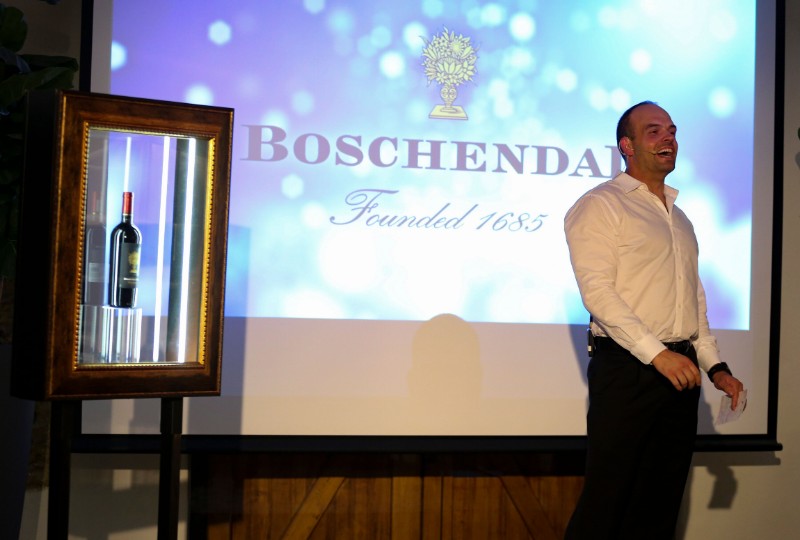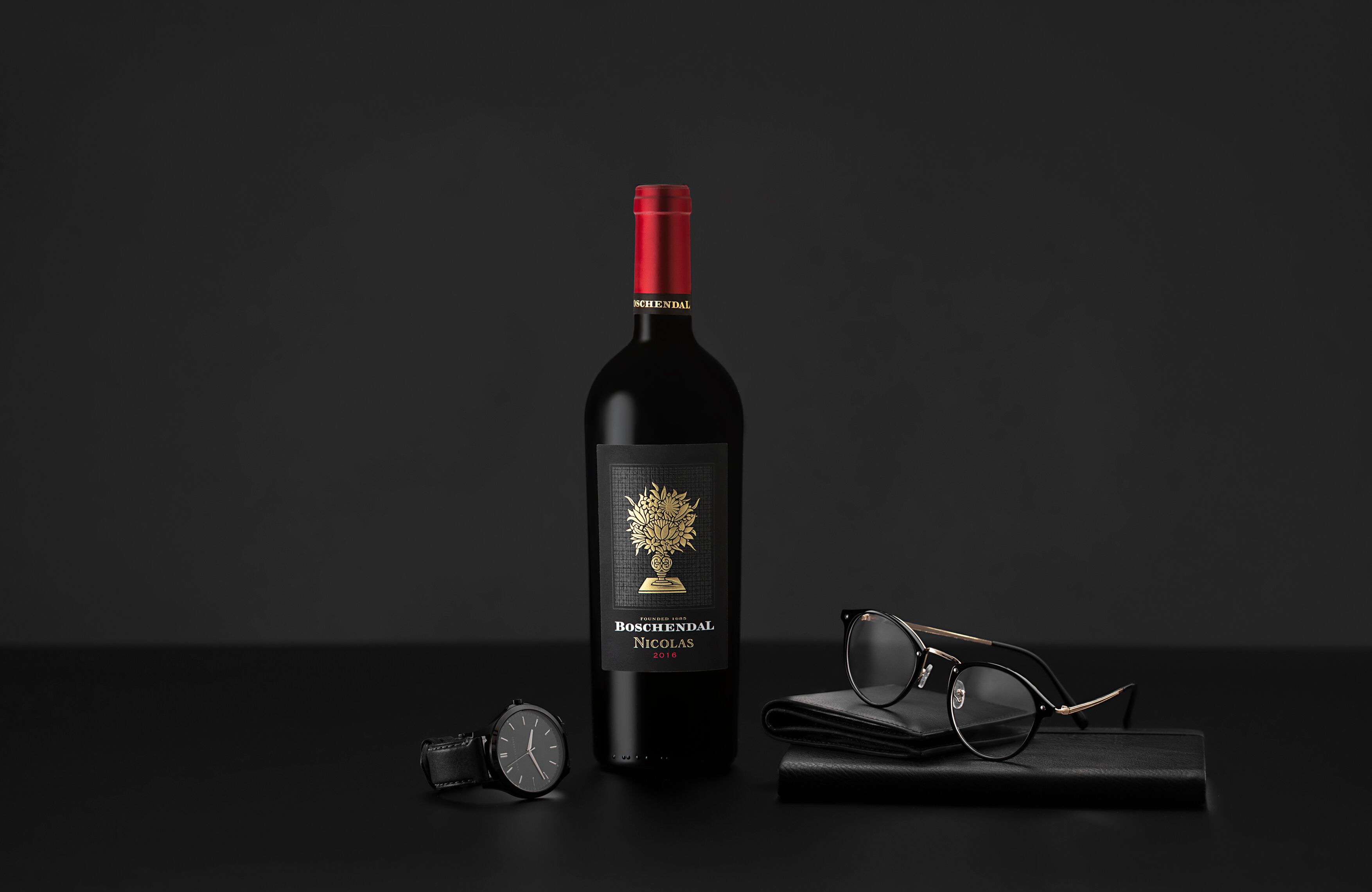“We are so proud of this wine. It is a blend of exceptional components, which together have created something really special.” Jacques Viljoen.
The legacy of Nicolas de Lanoy – one of Boschendal’s pioneers – was honoured this week with the introduction of a distinctive new red blend, Nicolas 2016. The highly-anticipated wine expertly blends the finest Shiraz, Petit Verdot, Cabernet Sauvignon, Malbec and Cabernet Franc in an enthralling, exceptional creation. It was launched this week in simultaneous celebrations in Johannesburg, Cape Town and Dusseldorf, Germany.
Boschendal is particularly proud of the wine because the 2016 vintage was a challenging one. However – according to Jacques Viljoen, Boschendal Cellar Master – Nicolas is proof that through adversity comes greatness.

Shirley van Wyk, Marketing Manager of Boschendal Wine, says the inspiration for Nicolas came from the tapestry that is evident in so many facets of Boschendal. “Our story is one of exceptional elements coming together to form something truly extraordinary. From pockets of land which knit perfectly together in a visual compilation, to the story of the combined farms of Jean de Long and Nicolas de Lanoy creating the estate we have today. From the perfect blending of our 334-year-old history with a modern, inspiring lifestyle, to the rich combination of sustainably-grown produce that forms the foundation for our farm-to-table philosophy. All these elements come together to create a legacy of excellence.”

Nicolas was created by a team led by Viljoen. Made from Shiraz (58%), Petit Verdot (14%), Cabernet Sauvignon (10%), Malbec (8%) and Cabernet Franc (3%) grapes, each variety was selected for the separate yet complementary qualities it brings to the blend.
Viljoen explains that the grapes are grown in high-lying, cool climate sites mostly from the Stellenbosch region, with a small percentage from the Swartland. “These are highly expressive, trellised vineyards. Their altitude, aspect and close proximity to the Atlantic Ocean yield fruit with a restrained classical elegance, good acidity and soft tannins. Farming practises are tailored for ultra-premium quality and grapes are harvested at perfect ripeness.”
Viljoen says that, upon arrival at the cellar, bunches are hand-sorted to ensure that any green berries are discarded. “The respective cultivars are vinified separately and treated very gently throughout the winemaking process to obtain the wine’s signature classical elegance. Primary and malolactic fermentation take place in stainless steel tanks before wines are matured in small French oak barrels for 16 months. These consist of 20% new wood, and the rest a combination of second, third and fourth fill barrels. After the meticulous tasting of the respective wines, the final blend is assembled and bottled.”
The bold and elegant Nicolas 2016 was launched on 18 March simultaneously at The Nicolas on Boschendal Estate, Daytona Johannesburg and The Ash Restaurant in Düsseldorf, Germany. Van Wyk calls the wine an incredibly exciting new blend for the estate and South Africa’s winemaking community at large, “This is a distinctive red blend that truly exemplifies all the best qualities of Boschendal brought together in one, perfect bottle.”
THE STORY OF NICOLAS DE LANOY
The Nicolas takes its name from one of Boschendal’s founding pioneers, Nicolas de Lanoy. He helped to lay an early foundation in the development of this iconic estate. The land was next to Boschendal and not always part of the property. After his death, his farm merged with the two adjacent farms to form Boschendal as it is known today. Like this layered blend, it is a farm founded from different parts of the land that were separate, but once brought together, have formed a place of incredible beauty and charisma.
Nicolas de Lanoy was a French Huguenot refugee who arrived at the Cape with his parents, Nicolas and Marie de Lanoy, in 1688. Within two years, the older Nicolas had died and the family appealed for assistance from the authorities. The family was granted a farm in Groot Drakenstein on 25 October 1690.
The original property was a long strip that lay in a west-east direction with the Simonsberg behind it and the Dwars River below. The homestead, Champagne, at the entrance to Rhodes Mile, marks the top of the farm and the main road (R310) crosses it. The Boschendal Werf now lies within the perimeters of Lanoy’s property before it drops down to the river.
Nicolas de Lanoy probably took on the role of man of the house. It was a pioneering existence and he would have had to clear the land to plant crops and build a dwelling of some sort. Known as the viticulturist of his time he is an integral part of the beginnings of Boschendal’s rich winemaking heritage. He would also have had to contend with extreme weather conditions and wild animals prowling around.
To the south-west of Lanoy’s farm was the farm, Goede Hoop, which was owned by another Huguenot, Pierre Jacob. Jacob and his wife Suzanne de Vos came from the same area as Lanoy; Calais in northern France. Historians assume they were close friends and when Jacob died in 1693, Lanoy married his widow, Suzanne. He seemed to have overcome the initial difficulties and made a living from both farms.
Nicolas and Suzanne’s names appear together in baptismal records from 1696-1704. They were called upon to be the godparents of his sister’s children. Marie de Lanoy first married to Ari Lecrevent then Hans Hendrik Hattingh and lived at Lekkerwijn. Hattingh subsequently acquired Goede Hoop from the estate of Suzanne de Vos in 1710.
Nicolas de Lanoy must have died a few years earlier as Suzanne is described as a widow in the title deed of Goede Hoop, which was only issued in 1708. Lanoy had no children of his own so the unnamed farm would also be sold from the joint estate.
Abraham de Villiers purchased Lanoy’s farm in 1710 and the adjacent farm of Jean Le Long in 1715. Henceforth the combined farms would be known as Boschendal. It would become the seat of the De Villiers family, who would eventually build a grand manor house on the section that belonged to Nicolas de Lanoy.




